Emplifi Project Case Study
Emplifi
A Comprehensive Recruitment CRM Case Study
Executive Summary
Overview
This case study explores Emplifi, a recruitment CRM that streamlines hiring from job posting to placement. It provides tools for managing clients, roles, and candidates, tailored for agencies and HR teams. The study highlights its architecture, workflow, and key features solving major recruitment challenges.
Business Challenges in Recruitment
Recruitment agencies and HR teams face challenges like managing multiple client needs, tracking candidates through complex workflows, coordinating between consultants and managers, generating reports, ensuring timely follow-ups, and measuring team performance.
Solution
Emplifi Recruitment CRM
Emplifi was developed as a comprehensive solution to address these challenges with a multi-faceted approach:
1. Dashboard & Analytics
The Emplifi dashboard provides at-a-glance metrics crucial for recruitment management:
- Total roles (72), vacancies (85), and candidates in pipeline (90)
- Visual breakdown of HR consultant workload and performance
- Quick navigation to key system areas
This centralized view allows managers to identify bottlenecks, allocate resources efficiently, and make data-driven decisions about recruitment strategy.
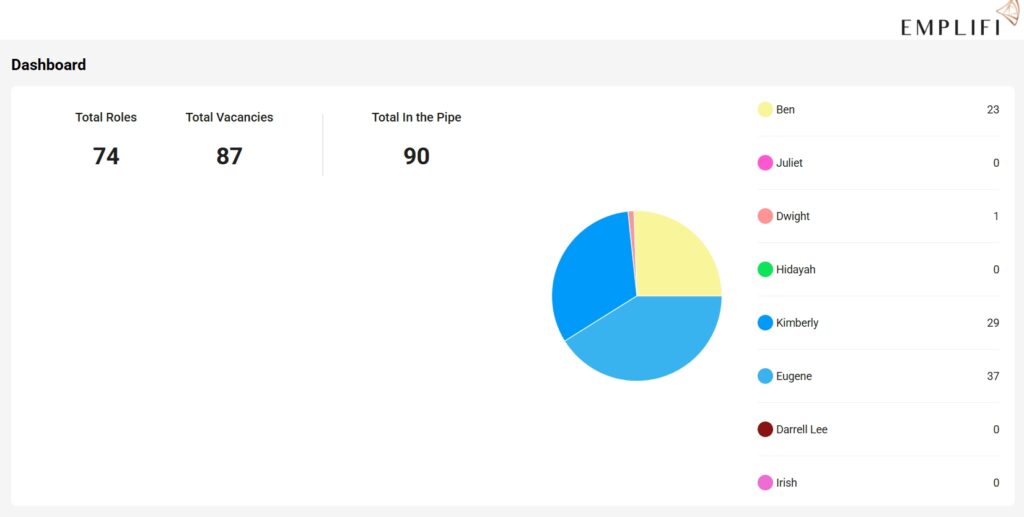
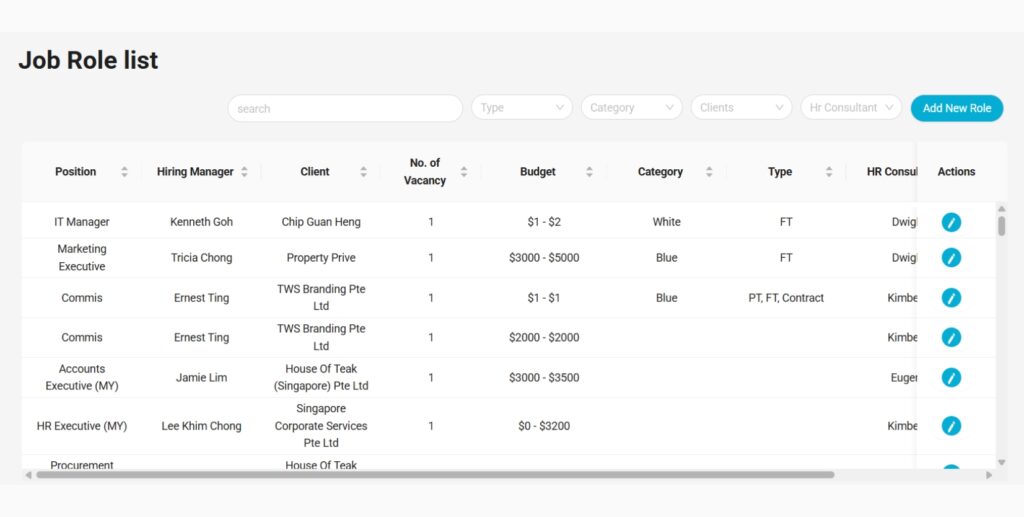
2. Job Role Management
The job role list feature allows staff to:
- Create and manage job postings with detailed specifications
- Assign hiring managers to specific roles
- Track vacancy numbers, budget ranges, and pipeline status
- Categorize positions (e.g., Blue category, FT/PT types)
- Assign HR consultants to oversee specific roles
- Monitor pipeline progress for each position
This structured approach ensures clear responsibility assignment and comprehensive tracking of all open positions
3. Client & Group Management
Emplifi organizes clients into logical groups for streamlined management:
- Groups can contain multiple related clients (e.g., TWS/Swee Choon Group)
- Each client has associated contact persons
- Vacancy tracking at both client and group levels
- HR consultant assignment at group level
- Pipeline visibility across the entire group
This hierarchical structure is particularly valuable for agencies working with enterprise clients that have multiple divisions or related companies.
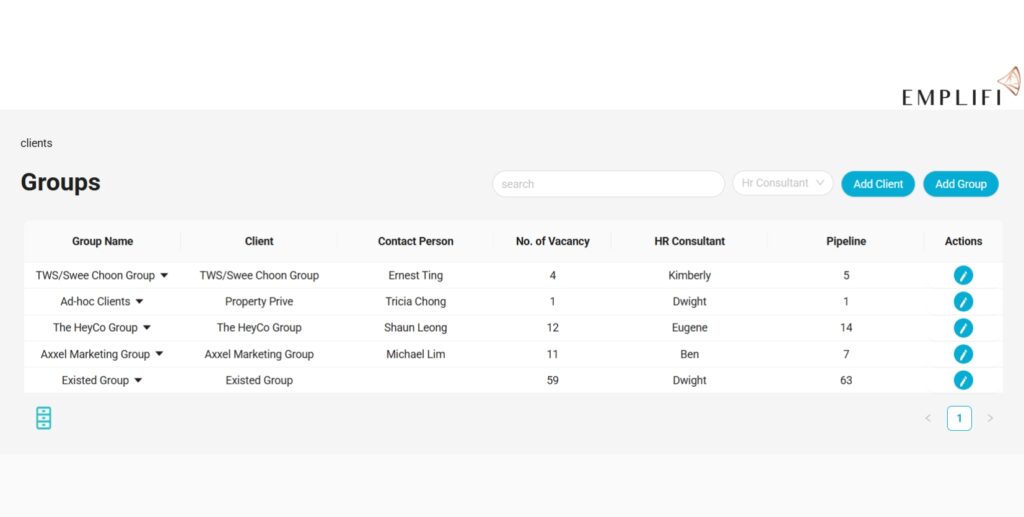
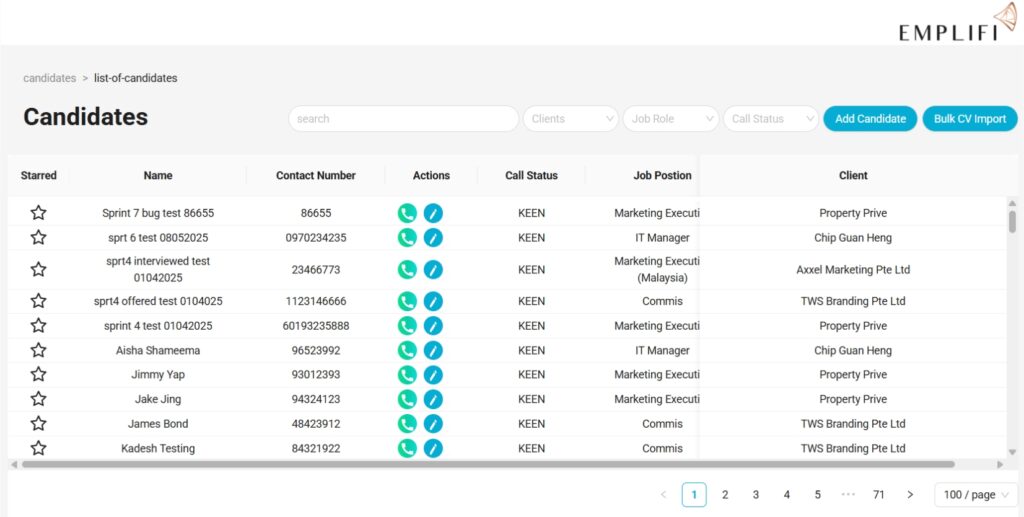
4. Candidate Management
The candidate management system offers:
- Comprehensive candidate listings with contact information
- Job position and client assignment
- Call status tracking (all marked as "KEEN" in the example)
- Star/favorite functionality for priority candidates
- Bulk CV import capability
- Filtering by clients, job roles, and call status
This centralized candidate database ensures no potential hire falls through the cracks.
5. Kanban Recruitment Workflow
Perhaps the most powerful feature is the Kanban board that visualizes the recruitment pipeline:
- Clear columns representing each stage: PROFILED (54), SCHEDULED (4), INTERVIEWED (17), FAILED (68), CDD WITHDRAW (74), OFFERED (15), SIGNED
- Visual cards for each candidate showing position and company
- Color-coding for status tracking (cards turn red after 72 hours in certain stages)
- Automated movement between stages based on scheduled events (powered by BullMQ)
- Custom column creation capability
This visual workflow allows teams to immediately identify where candidates are in the process and which stages may be creating bottlenecks.
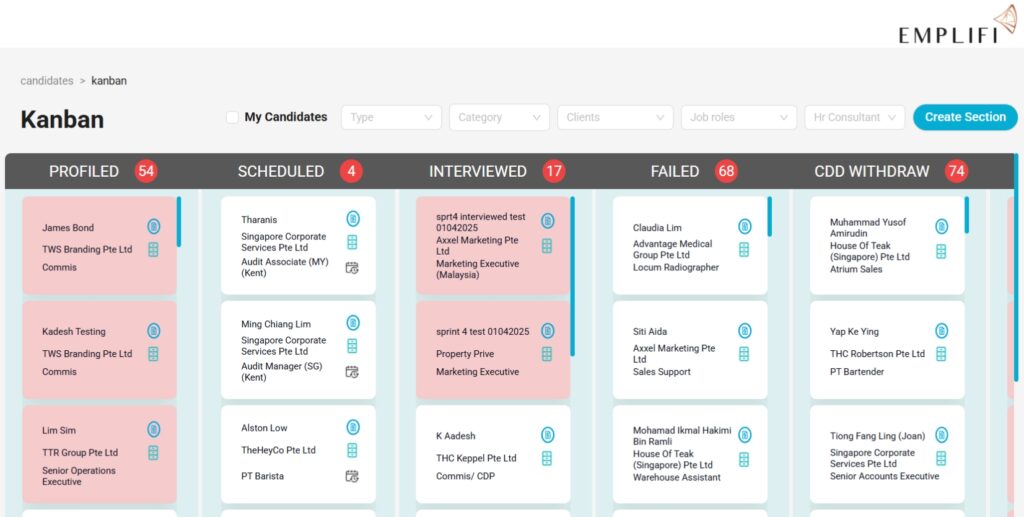
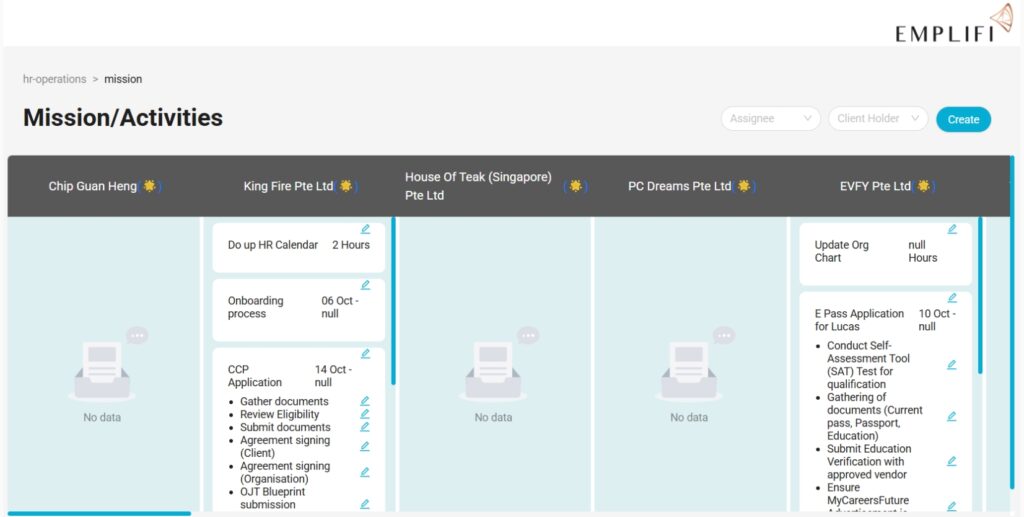
6. Mission/Activities Management
The Mission/Activities feature facilitates task management for specific clients:
- Task assignment and tracking
- Process documentation for standardized recruitment steps
- Time tracking for activities
- Checklists for complex processes (e.g., CCP Application)
- Onboarding process management
This ensures all necessary steps are completed for each client engagement.
7. Reporting & Analytics
Emplifi offers robust reporting capabilities:
- CV Reports tracking staff performance metrics (calls, unique calls, missed calls, CV uploads)
- HRTA Reports showing conversion rates between stages (e.g., 7.47% of CVs purchased lead to profiling)
- Placement and salary reporting
- Talent acquisition value analysis
- Time-based filtering (Today, This Week, Last Week, etc.)
These reports provide crucial insights into team performance and process efficiency.
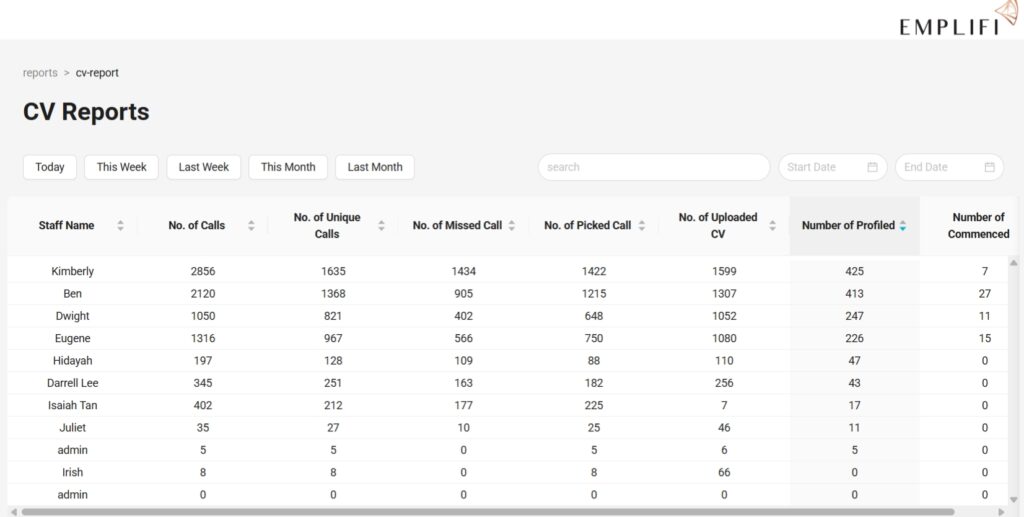
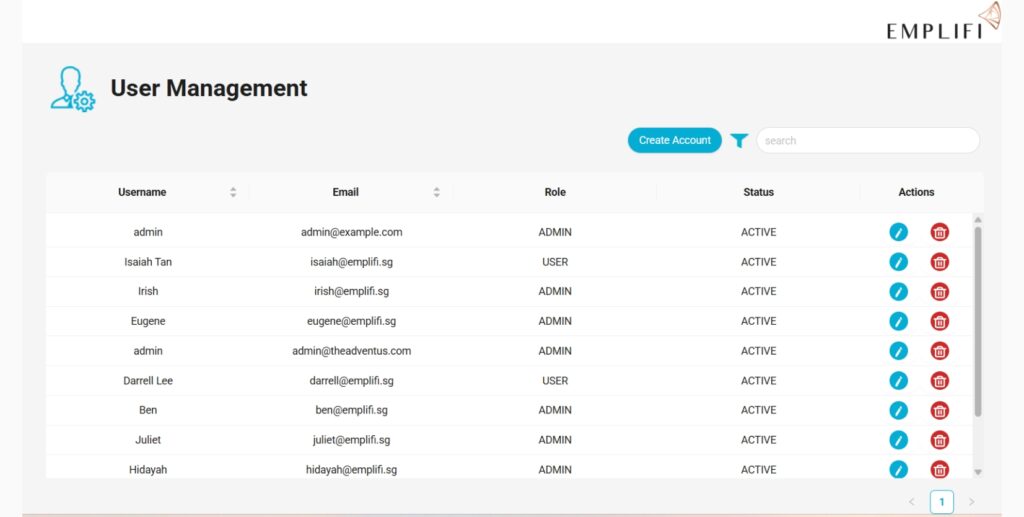
8. User Management
The admin interface allows:
- User creation and role assignment (Admin vs. User)
- Status management (Active/Inactive)
- Email and contact information tracking
- Permission control based on role
This ensures proper access control and security for the recruitment data.
Technical Implementation
Key technical aspects of the Emplifi system include
BullMQ Integration
Automated time-based transitions between recruitment stages (e.g., moving candidates from SCHEDULED to INTERVIEWED based on interview time)
Notification System
In-app popup notifications for important events (e.g., candidate has been in SIGNED stage for 2 weeks)
Role-Based Access Control
Different permissions for Admin and User roles
Color-Coding System
Visual indicators for time-sensitive items (cards turning red after 72 hours)
Search & Filter Functionality
Throughout all major components of the system
Benefits
Results & Measurable
The implementation of Emplifi delivers significant advantages
Improved Process Efficiency
Standardized workflow with clear ownership and status tracking
Enhanced Visibility
Comprehensive dashboard and reporting for performance metrics
Reduced Candidate Dropout
Automated follow-ups and time-based alerts prevent candidates from being forgotten
Better Team Collaboration
Clear assignment of responsibilities between HR consultants
Data-Driven Decisions
Conversion metrics and performance analytics guide process improvements
Streamlined Client Management
Hierarchical organization of clients and their job requirements

Insights
Challenges & Solutions
During the implementation, several challenges were addressed
Complex Workflow Management
Solved by implementing the visual Kanban system with automated stage transitions
Performance Tracking
Addressed through comprehensive CV and HRTA reports analysis and evaluation
Client Organization
Resolved with the hierarchical group-client structure
Time-Sensitive Follow-ups
Managed through the BullMQ integration and color-coding system
User Adoption
Facilitated by intuitive UI design and role-based access control
Next
Future Enhancements
Potential future improvements for the Emplifi system include the development of a mobile application to enable on-the-go recruitment management, enhancing accessibility and flexibility for users. Integrating AI-powered matching algorithms based on CV analysis can significantly streamline the candidate-job matching process, ensuring more accurate and efficient hiring decisions. The addition of native video interview capabilities within the platform would offer a seamless experience for both recruiters and candidates. Predictive analytics could be leveraged to forecast hiring timelines using historical data, aiding in better planning and decision-making. Lastly, introducing a client portal would provide limited access for clients to monitor the progress of their open positions, promoting transparency and collaboration.
now
Conclusion
This Recruitment CRM Case Study showcases how Emplifi provides a comprehensive solution to the complex challenges of recruitment management. By combining client management, job tracking, candidate progression, and performance analytics in a single platform, it enables recruitment professionals to work more efficiently and effectively. The system’s thoughtful design addresses the entire recruitment lifecycle while providing the flexibility to adapt to different organizational needs.
The implementation of automation features like BullMQ for stage transitions and time-based notifications helps prevent candidates from falling through the cracks, while the robust reporting system ensures that team performance can be accurately measured and improved. Overall, Emplifi stands as an excellent example of how thoughtfully designed software can transform a complex business process into a streamlined workflow.



